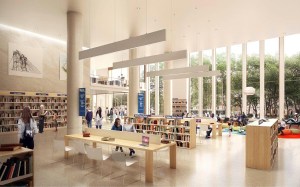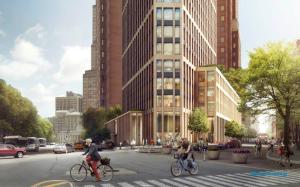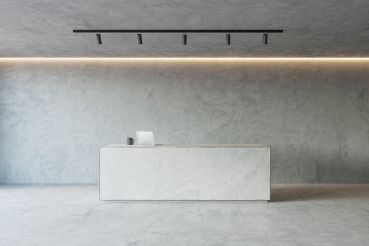David Kramer’s Hudson Companies Is Making Waves in Brooklyn—Starting With a New Library
By Lauren Elkies Schram September 23, 2015 10:30 am
reprints
While some development companies try to veer away from problem projects, Hudson Companies steers toward them.
“We tend to be more successful when the project has some hair on it—there’s some complication,” said David Kramer, the president of Hudson. “That’s where we have a competitive advantage, I think.”
Since the firm’s inception in 1986, Hudson has completed 46 projects with 5,421 units—and it has another 16 projects with 4,875 units in development, under construction or in the pipeline. Much of what the firm is involved in is in Kings County.
Three of the company’s biggest Brooklyn projects are the redevelopment of the site of Brooklyn Heights Library at 280 Cadman Plaza West, the construction of a residential high-rise at 626 Flatbush Avenue in Prospect Lefferts Gardens and the three-phase affordable housing project Gateway Elton in East New York.
Mr. Kramer, who turned 50 last week and grew up on the Upper West Side attending the private all-boys Collegiate School, will celebrate his 20-year anniversary with Hudson in October. Commercial Observer talked with him in the company’s 11th-floor offices at 826 Broadway near Union Square about the company, lawsuits from community activists and how homeowners were the pioneers in Prospect Lefferts Gardens.
Can you provide a brief history of Hudson?
Hudson’s been around since 1986, primarily as a residential developer. What I like to say is: primarily the five boroughs, primarily new construction, but within residential new construction we build tall and small, fat and skinny, two-family homes [and] 36-story condos. So it’s a mix within the residential world and we have four buckets of business. We do affordable housing, which we’ve done since the start, on one end of the income spectrum, and on the other end of the income spectrum is market-rate luxury condos and rentals and then a third bucket is institutional and middle-market housing—so building a dorm for [New York University], building staff housing for [Memorial] Sloan-Kettering. We’re building the residential tower for the Cornell [NYC] Tech campus [on Roosevelt Island], the largest passive house in the world. Also in the middle-market I would say we have a separate account with New York City’s pension system where we develop sort of outer-borough workforce housing. The fourth bucket is buying existing portfolios, a lot of which we’re doing through the pension fund.
How did the company get its start in Brooklyn?
So, Hudson’s DNA has always been to look for the next neighborhood. We’re really not doing a lot in Manhattan right now. Roosevelt Island counts as Manhattan, sort of. It just has to do with your risk profile and how you want to spend your day. You could buy a site in West Chelsea and hope to hit a home run selling condos at $3,500 a foot—and we’ve been more on the opposite end thinking about what’s our break even, and making sure when the downturn hits we’ll still be okay buying land at a price that doesn’t seem exorbitant. You know, we’ve done land deals in the last year or so at $50, $60, $70 a foot. So that’s just sort of how we feel comfortable operating…we find neighborhoods like Prospect Lefferts Gardens, or Kensington or Dumbo 15 years ago, or Gowanus, where we feel that the right elements are in place.
We were one of the first to do ground-up new construction in the East Village in the mid-90s, in the year when Rent was winning the Tony for best musical about people in the East Village not paying rent and we were building an 80/20 on East Sixth Street called The Hudson East. We were the first to the Meatpacking District. We did 345 West 13th Street on 13th and Hudson [streets] across from what is now the Gansevoort Hotel but when we were doing it, it was a parking lot. We were one of the first in Clinton, west of 10th Avenue at 520 West 48th Street. We were one of the first in West Chelsea when we did the Marais at 520 West 23rd Street before there was a High Line. Our big mistake in life is not doing 17 projects when we were there.
We did a lot of affordable housing in Brooklyn in the ’80s and ’90s [but] I would say our first big Brooklyn project was J Condo in Dumbo at 100 Jay Street. It’s a big project—that’s a 33-story tower, 267 units, 400-car garage, ground-floor retail—and that was a big success for us. Since then we’ve ridden the Brooklyn wave to go from subway station to subway station as we get deeper and deeper into Brooklyn. We’re doing projects in Brighton Beach and Bergen Beach.
Why don’t you have your office in Brooklyn since you have so much development there?
We’ve thought about it. The transactional world is still for the most part in Manhattan in terms of the meetings we have here with our investors, architects, consultants, engineers [and] not everybody in the office lives in Brooklyn. A lot of people live in Northern Manhattan so Union Square is a good hub.

Was the library building purchase price $52 million?
Yes [but] the value is more than that because we’re also giving them a new library and we’re paying for their interim library so it’s really more than $60 million when you count everything. But they’re getting $52 million.
The project entered the ULURP process in June.
We had a very successful vote with the community board maybe in early July. They voted basically by a two to one ratio to approve the project and then we went to the borough president [on Aug. 18]. This project has a group of library folks that are doggedly determined to fight the Brooklyn Public Library, everywhere on every project. These outspoken advocates are of the deluded opinion that the people running the BPL hate libraries and are shills for the real estate community and you know, also fear change because the Brooklyn Public Library is trying to come up with thoughtful strategies to help fund their capital needs.
One of the complaints was that the new library will be smaller. How big is the current one?
You could answer that many different ways. Currently it’s a two-story building that’s a little more than 30,000 square feet. There are also two floors below grade that were built as a fall-out shelter that now store books but they’re not open to the public. The opponents would say it’s a 60,000-square-foot building because they want to include the fall-out shelter. Of the 33,000-square-foot building, the building houses the business branch for the Brooklyn Public Library and the neighborhood branch for Brooklyn Heights. BPL has for years wanted to relocate the business branch back to the central Brooklyn library building, at Grand Army Plaza. The neighborhood branch is increasing from 18,000 to 21,500 square feet. An opponent could say it’s 60,000 square feet—or it’s 33,000 square feet—and now it’s 21,000 square feet, but the truth is that the BPL looked at the size of their neighborhood branches and how big they should be—and their biggest branches are basically 21,500 square feet. It’s going to have the most usable square footage. And we’re paying in perpetuity for their HVAC system.

When would you hope to finish the project by?
We hope to start construction next summer and it’ll be probably three years of construction. But, let’s get to the important thing. This is going to be the best new building in the city. It’s going to be the best condo in Brooklyn. It is the best location for new development in Brooklyn. It has a beautiful design by Marvel Architects that we love. It’s going to have a beautiful new library with great ceiling heights.
What’s the cost of the whole project?
It’s a half a billion dollars, including the affordable housing. We’re building 114 units of affordable housing in two locations within Community Board 2. One of the reasons we were designated is that…we were required to build 55 units but we added some middle-income and moderate-income apartments so we have, not 55, but 114 units of affordable housing. We’re building a fabulous new building. We’re building two affordable housing projects. At the end [the library will] own their condo. A lot of the opponents say, “You’re selling city land.” Well, kind of. We’re selling the land, but then you’re owning the condo.
What about this community space for Saint Ann’s School [where his three children, ages 16, 14 and 10 go to school]?
It’s complicated. So, we were designated as part of a competitive [request for proposals] and we partnered with Saint Ann’s during the RFP process so our proposal was to build a new library, a new residential building and a new theater for Saint Ann’s below grade. And unfortunately, they just finished a three-year capital campaign to raise money for their many existing needs so they determined they couldn’t take on this new theater project at the same time they were doing everything else. So, anticipating that it wasn’t a guarantee that Saint Ann’s could raise the money to do the project, we said to [New York City Economic Development Corp.], “I don’t want to be accused of a bait-and-switch so if it doesn’t work out—let’s come up with a plan B.” The plan B we came up with is to make a good faith effort to find a substitute community facility user who would be interested in comparable economic deal. The economic deal is basically that we were doing it at cost. So we are in the process now.
What do you have there in terms of retail?
Two small retail spaces on Clinton Street. Micro-retail. Four hundred square feet a piece. So the idea is one is going to be a Brooklyn Roasting Company space. They’re going to basically have a takeout stand on Clinton Street because you can’t have a big fancy project without some caffeine involved. And then the other space is going to be a curated by Smorgasburg. Smorgasburg is going to curate a monthly rotating vendor in one of the micro-spaces and the idea is that you take a Smorgasburg vendor whose business model consists of operating a kiosk on a weekend to test their operation, see if they can run a brick-and-mortar business. The idea is it’s for a month. It’s a pop-up. I thought it’d be fun because one vendor will be selling hot chocolate in February and one vendor will be selling popsicles in August. It’ll be fun for the library patrons and the condo owners and the Saint Ann’s kids to go and see who’s the new vendor [each month].
You also had community resistance at the 626 Flatbush site.
Indeed. [Laughs]
How did your company respond to the protesting?
With grace and humor. How else could we? 626 Flatbush nobody should be opposed to. It is an as-of-right project that’s an 80/20 so we’re bringing affordable housing to the location. We’re bringing new development to a neighborhood—Prospect Lefferts Gardens—that hasn’t seen a new building go up in decades. We’re designing another great project with Marvel Architects. We’re going to have ground-floor retail and we’re going to have fantastic apartments and we took a huge risk. It’s going to be done at the end of this year. It’s right near the Q train so you have an express train and can be at Union Square in 20 minutes. It’s two blocks from Prospect Park. There are green shoots of retail along Flatbush Avenue and we weren’t asking for any favoritism, we weren’t asking for any discretionary approvals, we didn’t go for rezoning. We just build as-of-right, which is what Hudson does. Hudson has always built as-of-right. [Then] there was a frivolous lawsuit that wanted to stop the project and came up with silly reasons that were thrown out by a judge.
Who was suing you exactly?
It was like a few neighbors. This was 15 months ago. There are always going to be a few neighbors who don’t like a tall building being built so they complained. So, was there a lot of community opposition? I didn’t feel it. I’ve talked to homeowners who are excited that there is a new rental building in the neighborhood. In fact, [the project] wasn’t even my idea. It was my college roommate’s idea. He lived in a house in Prospect Lefferts Gardens and he said, “there are all these beautiful homes in Prospect Lefferts Gardens that used to be selling for $1.2 million and now they’re selling for $1.8 million or $1.9 million and yet there’s not a lot of great rental housing stock on Flatbush Avenue. But if homeowners are willing to spend up to $2 million to buy a townhouse here, you would think that renters would be happy to have a nice rental apartment.” In the usual dynamic of real estate, renters are the pioneers. People discover a neighborhood and then they rent and the neighborhood becomes cool and someone says, “this neighborhood has become popular enough, maybe we could do a condo here.” In Prospect Lefferts Gardens, the owners are there first.
Do you have projects in the other outer boroughs?
Because Brooklyn is getting so expensive we’re sniffing around Queens and the Bronx. We’re working on two projects, one each in the Bronx and Queens.
Are most your deals off-market?
Sometimes. We’ve never been one to be the high bidder on a project that is well-marketed and has multiple offers. That’s just not our sweet spot. If you look at a lot of the things we do, even the Brooklyn Public Library, there’s a lot of conflict, there’s a lot of working with multiple public agencies. That’s not for everybody.
You grew up on the Upper West Side. Why’d you decide to live in Brooklyn?
I’ve been part of the great Brooklyn migration. We started in Dumbo. When we were expecting our first kid we were the third pioneers to move into the first Dumbo project, 1 Main Street. In Dumbo, we bought a loft for $250 a foot. And living in Dumbo was probably part of our developing J Condo and we’ve loved being there ever since. And so we moved from a loft in Dumbo to a house in Brooklyn Heights [12 years ago].
Let’s talk about your East New York rental project, Gateway Elton Street.
It’s affordable [housing]. It’s a three-phase [$233 million] project. Two of the phases are complete. It’s under construction and will be done in a year. We should talk about 22 Caton Place. We just finished it and we’re renting it out. We’re leasing it up now. We’re 50 percent leased. We’re getting $2,600, $2,700 for one-bedroom apartments. 22 Caton is a perfect example of we picked a neighborhood in Kensington that was off the beaten path. We took a huge risk building an apartment building there hoping to get one-bedroom rents of $2,200 and worrying that that was a leap of faith. The good news is it’s worked out well. The bad news is it shows how expensive Brooklyn is getting if one-bedrooms at Caton Place…are $2,600 to $2,700. That means for Hudson that our next projects are going to be that much more challenging to find the right location.


